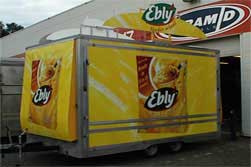 |
 |
Stay updated!
Printing is a diverse and ever evolving industry. Stay ahead of the game by subscribing to our news.
Featured Videos
View the videos below to see our work in action.
Feel free to browse our Video Gallery
-
Gallery of Services
Notice: Undefined index: id in /home/ddlounge/pyramidvisuals.co.uk/inc/imgblock.php on line 35
Notice: Undefined index: class in /home/ddlounge/pyramidvisuals.co.uk/inc/imgblock.php on line 39
Notice: Undefined variable: size in /home/ddlounge/pyramidvisuals.co.uk/inc/imgblock.php on line 57


Feel free to browse our showcase galleries featuring some of the best exhibition displays, retail displays, point of sale and point of purchase displays as well as a host of vehicle branding solutions as well as outdoor media such as building wraps and large outdoor banners.
Read More ›
History of Billboards
Billboard printing history and where billboards came from
History of Billboards and Outdoor advertising
Billboards are a collation of photos, logos and information. They can be humourous, containing witty slogans, and they can also be strange or ironic however; no matter what message they are trying to convey, they are memorable images that help to make our lives more worthwhile.
Billboards are extremely helpful in informing people of the location of nearby places to eat, sleep, and find the nearest petrol stations and ATM machines. Imagine this; find yourself in an unfamiliar location in need of food, rest and petrol. There is nobody around to point you in the right direction. Where do you get the information? Billboards are a critical tool in advertising, as they are seen by drivers, pedestrians and anybody that passes by. They help to promote business, and are not only used for advertising, but can also help to market both new and available products and services. They are very valuable to small businesses that do not have the money to spend on more expensive forms of advertising such as TV & radio commercials.
This is because billboards are the least expensive forms of advertising and they reach far more people than other mediums. Billboards are a symbol of development and civilization. The most impactful billboards are the bulletins as they are the most visible form of billboard, not just because of their size, but because they allow creative customising through their extensions and embellishments. Billboards are useful because instead of a business having to find their customers, they see the billboard advertising and seek out the company.
Billboards are prominent reflections of human history and human survival. They appear everywhere in all shapes and sizes, and reflect upon present events and the living conditions of today. They can convey significant messages and be for advertisement, personal or political purposes. Billboards are an example of the development of outdoor advertising and an expression of the development of life itself.
Billboards can be traced back to the earliest Egyptian civilization. Thousands of years ago, the Egyptians used tall obelisks made out of stone to demonstrate its laws and treaties to the public, making it the earliest known form of outdoor advertising. It may appear to be very political however; it is still a form of advertising. In 1450, Johannes Gutenberg invented movable type printing, introducing modern advertising through the handbill. The perfection of the lithographic process led to the construction of the first illustrated poster in 1796. As time passed people seeked more desirable locations to make sure that the maximum amount of people saw the advert, and that their message could be communicated as clearly as possible. Structures were constructed in locations where heavy traffic was prone to enhance maximum exposure.
Before billboard structures were fully erected, Americans used roadside advertising for local purposes. Merchants and businessmen would either glue posters or paint signs to walls and fences to advertise their establishment details, and what they have to offer a potential customer.
Measuring at more than 50 square feet, the first large outdoor poster was displayed in New York. This poster was created to advertise the circus in 1835. 1850 saw the introduction of street railway advertisements. National billboard campaigns revolutionised in the 1900’s when they became mass produced for the national market. Products such as toothpaste, soaps, breakfast cereals and fizzy drinks were some of the first to have been advertised in this way. In 1913, the concept of filling open board structures was introduced. During the First World War the industries made a concerted effort to make troops and supplies ready for battle. This message was hugely conveyed in both billboards and posters. After the war, billboards were communicating peace, and the country’s efforts to improve the general way of life. Nowadays billboards display witty slogans and distinctive visuals. They are highly visible in the top designated market areas.
View our Services